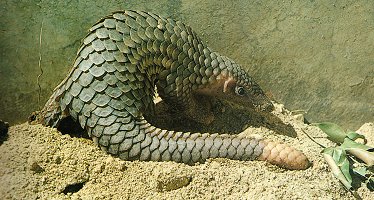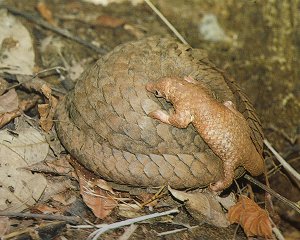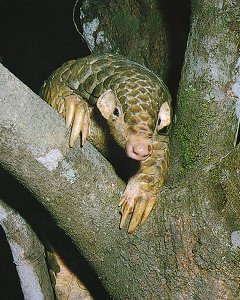THE ORDER PHOLIDOTA
Pholidota – Scaly Anteaters – 7 Species
In the tropical and subtropical regions of southern Asia and Africa are found seven species that constitute the entire order of Pholidota. These scaly anteaters are mainly terrestrial creatures but are also arboreal at times, and they look like walking pinecones. Once grouped with the other anteaters in the order Edentata, which is Latin for “knocked out teeth” since they have no teeth, biologists have recently given the Pangolins their own order, and have replaced the Edentata order with the order Xenarthra.

The scales are modified hair and shield the animal from enemies, especially when it curls itself into a tight coil or ball. “Pangolin” is a Malaysian word for “roll into a ball.” Like so many other natural curiosities such as the Rhinoceros horn, the Chinese people feel that the ground-up scales of the pangolin are medicinally good, and they are hunted for those scales. Pangolins are also hunted for their meat, but it is the loss of their natural habitat by encroaching civilization that most directly endangers the future of the pangolin.
The pangolin can extend its razor-edged scales, and lashing with its tail can inflict quite serious gashes in an enemy. Some species, just as the skunks, are able to spray their enemies with a foulsmelling liquid produced by glands near the anus. Add to this the ability to roll into an armored ball, and the pangolin is not threatened with being pushed out by any other order of mammals.

Its limbs are strong, and the heavy tail, though not prehensile, acts as further support when the pangolin rears up on its hind legs to tear away at the termite mounds or fallen logs with its sicklelike claws in search of ants and termites, its principal diet. It will eat other small insects as well. Since the pangolin has no teeth, its stomach is provided with thick, muscular walls and contains small pebbles which grind up the insects, much like a bird’s gizzard. The exceptionally long, whiplike tongue is anchored to the pelvis!
Many of the peculiar adaptations to its specialized diets of ants, such as long snout and tongue, sharp digging claws, absence of teeth, and even its protective shell of scales and ability to roll up into a ball are very suggestive of the Xenarthrans, but it is interesting to note, that the two orders are not closely related. Like the aardvark, the pangolin is a prime example of convergent evolution – two different types of animals arriving at the same form through natural selection.

Scaly anteaters, or pangolins, are not considered to be close relatives of the anteaters or armadillos, which are now grouped with sloths (Xenarthra).
Cape pangolin – MANIS TEMMINCKII
Possibly Endangered
- Class: Animals with Milk Glands (Mammalia)
- Subclass: True Mammals (Eutheria)
- Order: (Pholidota)
- Family: Manidae.
The name “pangolin”: “Pangolin” is a Malaysian word for “rolling up into a ball,” which the pangolin does to protect itself from enemies. See the picture below. If anyone knows what the word “Pholidota” means.

Location: East Africa, Sudan, Central African Republic, and the southern region of Africa with the exception of the coastal Cape region; India and Southeast Asia.
Habitat: Mainly terrestrial, but some species are at times also arboreal. It prefers arid zones with little vegetation and preferably with sandy ground.
Description: This animal looks like a lizard-shaped pine cone, with tiny ears and a large tail which in some species is longer than its body. It is completely covered with scales. Three of the five toes on the forefeet are well developed and have large strong claws. The claws on the hind feet are shorter. Its head and body length is about 20″, and it weighs about 20 lbs.
Behavior: The cape pangolin lives on the ground, but some other species are quite adept in the trees. It moves slowly, often on just the hind legs, balancing itself with its tail. It generally leads a solitary existence and forms pairs for only a brief time during the mating season. Although its other senses are not acute, it has a highly developed sense of smell which it uses to find the ant and termite colonies that provide its diet. It is toothless and uses its long sticky tongue to captures these insects. A nocturnal creature, like the aardvark it is only rarely seen in daylight. If attacked, the pangolin can curl itself into an armored ball, but it can also inflict serious injury on enemies by slashing with its very sharp scales on its tail. It can also spray a foul-smelling liquid, like a skunk.
Reproduction: The female delivers a single young after a 140 day gestation period, and holds onto the mother with its tail. She can protect the baby by wrapping herself around it in a ball.
Check out the Xenarthra order with similar-looking Armadillos.
Or just flip to the index to find the other Armadillos.
